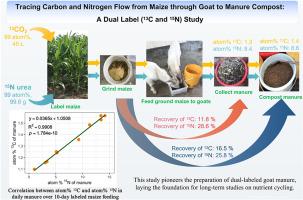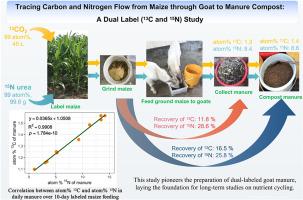追踪碳氮从玉米经山羊到粪肥堆肥:一个双标签(13C和15N)的研究
IF 10
1区 环境科学与生态学
Q1 ENGINEERING, ENVIRONMENTAL
引用次数: 0
摘要
作物-牲畜综合系统和有机肥施用是可持续农业的重要战略。了解碳(C)和氮(N)从作物,通过动物消化到粪便,然后进入土壤的循环是必不可少的。然而,由于制备双标签(13C和15N)粪便的高成本和技术复杂性,对这些过程的研究仍然很少,这阻碍了研究人员进行此类实验。本研究开创了双标签粪肥制备的先机,为长期养分循环研究中同时追踪饲料到粪肥的碳氮循环提供了方法框架。主要发现包括13C和15N在玉米不同组分(核、芯、叶、茎和根)、羊粪和堆肥中的分布。研究揭示了玉米对肥料中碳、氮的转化和恢复。例如,31.7%的粪C和27.3%的粪N来自玉米饲料,其中11.8%的饲料13C和28.6%的饲料15N在粪便中回收,16.5%和25.8%的饲料15N在堆肥中回收。堆肥增强了碳潴留,稳定了氮,提高了养分循环效率。玉米组织中13C与15N之间不存在相关性,但存在较强的线性关系(R2 = 0.9908, p <;在10天的饲养期内,山羊粪便中发现了0.001)。这些发现为后续追踪粪便堆肥中碳氮循环的研究提供了基础,对完善碳氮循环模型具有重要意义。未来的研究应该在不同的作物-牲畜系统中延长追踪期,以验证这些发现。本文章由计算机程序翻译,如有差异,请以英文原文为准。


Tracing carbon and nitrogen flow from maize through goat to manure compost: A dual label (13C and 15N) study
Integrated crop-livestock systems and organic manure application are vital strategies for sustainable agriculture. Understanding carbon (C) and nitrogen (N) cycling from crops, through animal digestion to manure, and subsequently to soil is essential. However, studies on these processes remain scarce due to high costs and technical complexities associated with preparing dual-labeled (13C and 15N) manure, which deter researchers from conducting such experiments. Our study pioneers dual-labeled manure preparation and provides a methodological framework for simultaneously tracing C and N cycling from feedstuffs to manure in long-term nutrient cycling research. Key findings include the distribution of 13C and 15N across different maize components (kernel, cob, leaves, stalk, and root), and goat manure, and compost. The study revealed the transformation and recovery of C and N from maize to manure. For instance, 31.7% of manure C and 27.3% of manure N originated from maize feed, with 11.8% of feed 13C and 28.6% of feed 15N recovered in manure, and 16.5% and 25.8% recovered in compost, respectively. Composting enhanced C retention and stabilized N, improving nutrient cycling efficiency. While no correlation between 13C and 15N was observed in maize tissues, a strong linear relationship (R2 = 0.9908, p < 0.001) was identified in goat manure during a 10-day feeding period. These findings provide a foundation for future studies tracing C and N cycling from manure compost, invaluable for refining C and N cycling models. Future studies should extend the tracing period across diverse crop-livestock systems to validate these findings.
求助全文
通过发布文献求助,成功后即可免费获取论文全文。
去求助
来源期刊

Journal of Cleaner Production
环境科学-工程:环境
CiteScore
20.40
自引率
9.00%
发文量
4720
审稿时长
111 days
期刊介绍:
The Journal of Cleaner Production is an international, transdisciplinary journal that addresses and discusses theoretical and practical Cleaner Production, Environmental, and Sustainability issues. It aims to help societies become more sustainable by focusing on the concept of 'Cleaner Production', which aims at preventing waste production and increasing efficiencies in energy, water, resources, and human capital use. The journal serves as a platform for corporations, governments, education institutions, regions, and societies to engage in discussions and research related to Cleaner Production, environmental, and sustainability practices.
 求助内容:
求助内容: 应助结果提醒方式:
应助结果提醒方式:


